Photographs of pollen from the NE Siberian Arctic
Pim de Klerk: Staatliches Museum für Naturkunde, Karlsruhe, Germany
Bastian Niemeyer: Alfred-Wegener-Institute, Helmholtz-Centre for Polar and Marine Research, Potsdam, Germany
Elena Raschke: Arctic and Antarctic Research Institute, St. Petersburg, Russia
Larisa Savelieva: Institute of Earth Sciences, St. Petersburg State University, Russia
Annette Teltewskoi: Institute of Botany and Landscape Ecology, Greifswald University, Germany
Martin Theuerkauf: Institute of Geography and Geology, Greifswald University, Germany
Hans Joosten: Institute of Botany and Landscape Ecology, Greifswald University, Germany
Appendix to:
De Klerk, P., Teltewskoi, A., Theuerkauf, M., Joosten, H. (2014):
Polar Biology 37: 1393-1412
The final publication is available at Springer via https://link.springer.com/article/10.1007/s00300-014-1529-3
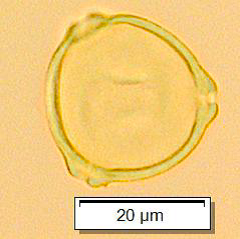 1
1
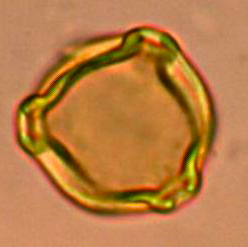 2
2
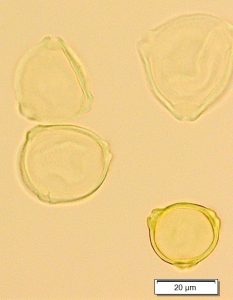 3
3
Pollen grains of Betula exilis, with slightly protruding pores (1) and prominently protruding pores (2); grain sizes and exine thickness vary greatly (3); photos by Larisa Savelieva/Elena Raschke, from: Savelieva et al. (2013)
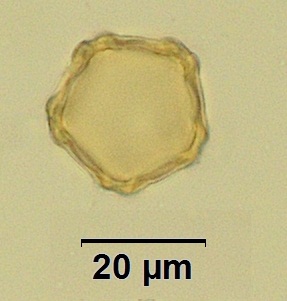 4
4
 5
5
Pollen grains of Duschekia fruticosa (Alnaster fruticosus, Alnus viridis ssp. fruticosa), with slightly protruding pores and only one, rather incospicuous arcus-like structure between the left and upper-left pores (4), and with prominently protruding pores with two well developed and three incospicuous arcus (5); grain sizes and exine thickness are variable; photos by Larisa Savelieva/Elena Raschke, from: Savelieva et al. (2013)
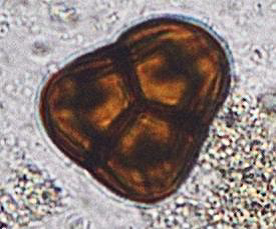 6
6
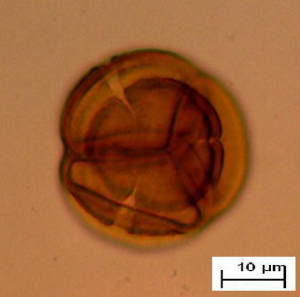 7
7
Pollen grains of Ledum palustre (6) and Vaccinium vitis-ideae (7); photos by Larisa Savelieva/Elena Raschke, from: Savelieva et al. (2013)
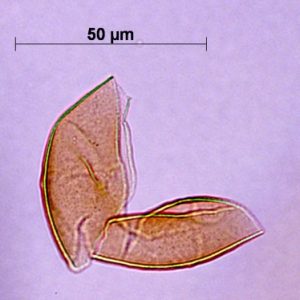 8
8
 9
9
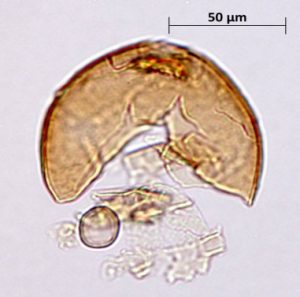 10
10
Pollen grains of Larix, pollen from completely developed cones (8, 9, 10) display severe damages including modifications of the pollen grain wall structure (10); photos by Bastian Niemeyer
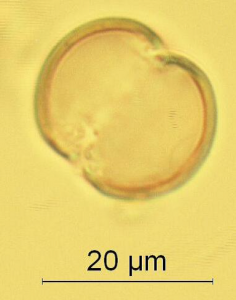 11
11
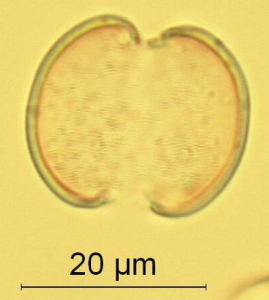 12
12
Pollen grains of Pedicularis lapponica; photos by Larisa Savelieva/Elena Raschke, from: Savelieva et al. (2013)
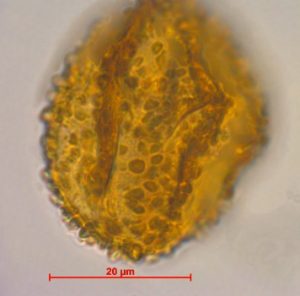 13
13
Grain of the pollen type RUBUS CHAMAEMORUS (sensu Beug 2004); from ice-wedge polygon mire Lhc11 near Kytalyk, peat section j20.10, sample at 7 cm depth; stacked photo by Martin Theuerkauf
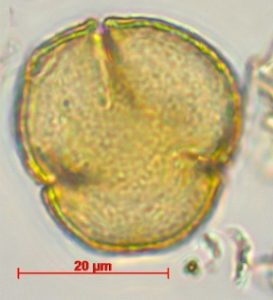 14
14
 15
15
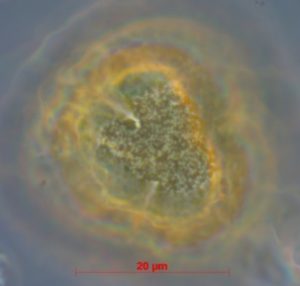 16
16
The pollen type RUMEX AQUATICUS T. (sensu Fægri & Iversen 1989), in the Kytalyk area produced by Rumex arcticus; both tricolporate grains (14) and tetracolporate grains occur (15); the pollen grain wall is scabrate (16); from ice-wedge polygon mire Lhc11 near Kytalyk, peat section j20.10, sample at 15 cm depth; stacked photos by Martin Theuerkauf
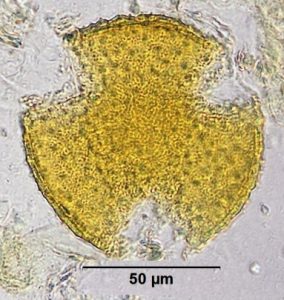 17
17
Pollen grain of Valeriana capitata; the echinae are often small and inconspicuous; photo by Larisa Savelieva/Elena Raschke, from: Savelieva et al. (2013)
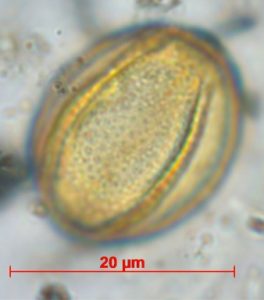 18
18
Unidentified 3-colpate pollen type with a scabrate wall structure; from ice-wedge polygon mire Lc04 near Chokurdakh, peat section h16; sample at 7 cm depth; stacked photo by Martin Theuerkauf
 19
19
Drawings of four different morphological types of Assulina muscorum tests. Types 1 and 2 have the greatest width in their upper third, and types 3 (asymmetrical) and type 4 (symmetrical) have the greatest width in the centre of the tests; redrawn after Schönborn & Peschke (1990)
 20
20
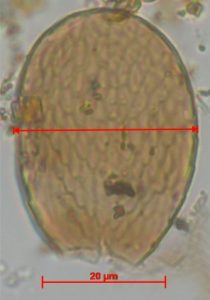 21
21
ASSULINA MUSCORUM TYPE 2 (20) with the largest width in the upper third of the shell, and ASSULINA MUSCORUM TYPE 4 (21) with the largest width in the centre; from ice-wedge polygon mire Lc04 near Chokurdakh, surface sample u23; photos by Martin Theuerkauf
 22
22
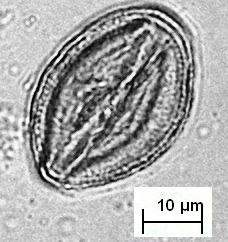 23
23
Pollen grains of Saxifraga cernua with a prevailing scabrate pollen wall structure and hardly detectable rugulae/striae; photos by Larisa Savelieva/Elena Raschke, from: Savelieva et al. (2013)
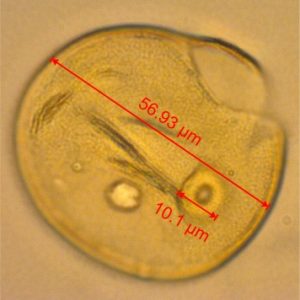 24
24
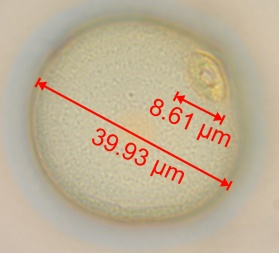 25
25
Pollen grains of Glyceria declinata with a slightly ovalish shape (24), and with a roundish shape (25); the pollen grains are variable in size; stacked photos by Martin Theuerkauf
Beug, H.J. (2004): Leitfaden der Pollenbestimmung für Mitteleuropa und angrenzende Gebiete. Verlag Dr. Friedrich Pfeil, München.
Fægri, K. & Iversen, J. (1989): Textbook of pollen analysis (revised by Fægri, K., Kaland, P.E. & Krzywinski, K.). Wiley, Chichester.
Savelieva, L.A., Raschke, E.A. & Titova, D.V. (2013): Photographic atlas of plants and pollen of the Lena River Delta. St-Petersburg State University, St-Petersburg.
Schönborn, W. & Peschke, P. (1990): Evolutionary studies on the Assulina-Valkanovia complex (Rhizopoda, Testaceafilosia) in Sphagnum and soil. Biol. Fertil. Soils 9: 95-100.
Your e-mail address will not be published.
Some nice pictures, but there are also some where the wall structure cannot be seen properly